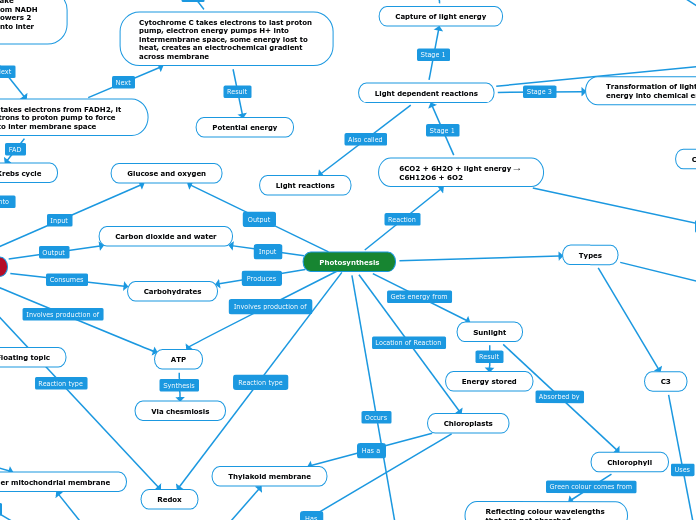Photosynthesis
Sunlight
Energy stored
Chlorophyll
Reflecting colour wavelengths
that are not absorbed
Chloroplasts
In the presence of sunlight
6CO2 + 6H2O + light energy →
C6H12O6 + 6O2
Light dependent reactions
Light reactions
Capture of light energy
Electrons in chlorophyll molecules attached to thylakoid membrane absorb a photon of light energy
Electron charged and moves from chlorophyll a to another pigment, electron passed along Antenna system to reaction centre
Primary electron acceptor captures electron, oxidizing reaction centre
Contains two arrangements
of pigments and proteins
Photosystem 680, used first
Photosystem 700, used second
Transfer of light energy
During photolysis, photosystem 680 removes electrons from H2O to release H+ ions
Diffuses out of chloroplast
Chesmiosmotic gradient created by pumping protons into lumen of thylakoids
Photosystem II transfers electrons to photosystem I, along a pathway from plasoquinone to 6-f complex to pastocynanin
Ferrodoxin transfers electrons to NADP reductase
Electron transport chain
Transformation of light
energy into chemical energy
ATP
Chesmiosmosis from proton motive force created by concentration difference between storm and lumen side
ATP synthase
NADH
NADPH created when NADP reductase uses electron energy to attach H+ to NADP+
Light-independent reactions
Calvin cycle
In carbon fixation, RuBP carboxylase catalyzes an exergonic reaction between 3 ribulose molecules and 3 CO2 molecules to create an unstable compound that splits into six total 2-phosphoglycerate, cycle happens six times for each glucose molecule
A phosphate group from ATP from light dependent reactions is added to each PGA molecule to make PGAP
PGAP goes through a reduction reaction powered by NADPH from previous reactions to make G3P
One G3P leaves, 5 stay to power cycle again
Produces carbohydrates
Glucose and Fructose
Sucrose and starch
During regeneration of RuBP, the 5 G3P that are not used to make carbohydrates combine with 3 phosphates and 3 ATP to create 3 RuBP molecules
Regeneration
Cycle to repeat itself
Types
C3
Rubisco to fix CO2 to RuBP
(3 Carbon atom), making
2 G3P
Does not do well in hot, dry area, less efficient when higher rate of photorespiration is required
C4
CAM
Photorespiration
Completing C4 pathway at night
time, Calvin cycle during day
time
Temporal seperation
Very efficient in hot, dry weather
Carbon fixed into four carbon atoms
Do better in hot, dry climates
Cellular Respiration
Chemical bonds
Energy released
Glucose and oxygen
Carbon dioxide and water
Mitochondria
A double cell membrane
Inner mitochondrial membrane
Thylakoid membrane
Carbohydrates
All the time
ATP
Via chesmiosis
Redox
𝐶6𝐻12𝑂6 + 6𝑂2→ 6𝐶𝑂2+ 6𝐻2𝑂 + energy in the form of ATP
Glycolysis
2 ATP consumed to be used later
6-carbon glucose molecule into 2
3-carbon molecules (G3P using 2 ATP after fourth reaction
Production of 2 NASH and 4 ATP + both G3P converted into 2 2-carbon pyruvate molecules
Anaerobic reaction
Pyruvate oxidation
CO2 molecule removed from
each 3-carbon pyruvate molecule
NAD+ oxidizes each 3-carbon
pyruvate molecule, addition of two electrons and protons creates NADH
and H+, leftover products create acetic acid
acetyl-CoA is created when
coenzyme A bonds to acetic acid
Krebs cycle
Acetyl-CoA
Citrate
Isocitrate
A-ketoglutarate
Succinyl-CoA
Succinate
Fumarate
Malate
Oxaloacetate
Reactant
Product
4 CO2, 6 NADH,
2 FADH2, 2 ATP
Twice
Electron transport chain/chesmiosis
NADH dehydrogenase enzyme take electrons from NADH, protons from NADH get moved into matrix, energy powers 2 proton pumps to move H+ ions into inter membrane space
Reenters Krebs cycle
NADH
Ubiquinone takes electrons from FADH2, it carries electrons to proton pump to force more H+ into inter membrane space
Returns to Krebs cycle
FADH2
Cytochrome C takes electrons to last proton pump, electron energy pumps H+ into intermembrane space, some energy lost to heat, creates an electrochemical gradient across membrane
Potential energy
Electrons have low energy from pumping H+, water is created when oxygen accepts these electrons and binds to 2H+
H+ channel proteins in membrane let H+ come into matrix creating kinetic energy with their movement creating ATP
